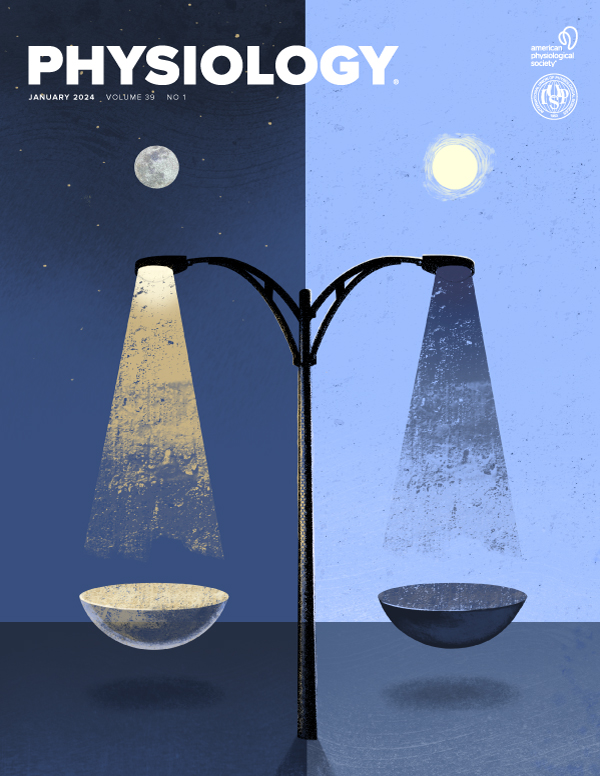雌激素通过增强一氧化氮的基础释放和内皮细胞SK通道活性来调节海马小动脉的肌原性张力
IF 5.3
2区 医学
Q1 PHYSIOLOGY
引用次数: 0
摘要
动脉和小动脉表现出肌源性张力,这是一种局部收缩的状态,可以根据血压的瞬间波动进一步收缩或扩张。排列在所有血管内表面的血管内皮控制着各种各样的基本功能,包括通过提供强直性血管舒张作用来控制邻近平滑肌细胞的收缩。在脑表面的大(顶)动脉上进行的研究表明,雌激素通过增强内皮细胞的一氧化氮(NO)释放来降低雌性小鼠的肌原性张力,然而,这种差异是否延伸到脑内微循环仍不清楚。现有的脑血管生理性别差异的不完整图景,加上脑血管意外后完全恢复认知功能的治疗方法的缺乏,使得研究雄性和雌性小鼠微循环中肌原性张力调节的必要性受到了重视。我们假设,性相关激素对肌原性张力的调节将其影响扩展到微循环水平,并试图在海马(一个主要的认知脑区)分离的小动脉中表征它。利用压力肌图实验中的直径测量,我们测量了生理相关压力下雌性小鼠海马小动脉的肌原性张力反应低于雄性小鼠。通过联合手术和药物方法,我们发现卵巢切除(OVX)雌性小鼠的肌原性张力与雄性小鼠相同,内皮剥离的小动脉也与雄性小鼠相同。有趣的是,eNOS抑制导致雌性小动脉收缩更大,但仅部分消除了音调差异。我们发现,残余差异是由小电导Ca2+敏感K+ (SK)通道的较高活性介导的。总的来说,这些数据表明,在生理压力下,eNOS和SK通道对雌性小鼠的肌原性张力有更大的血管扩张影响。R01HL136636;这是在2023年美国生理学峰会上发表的全文摘要,仅以HTML格式提供。此摘要没有附加版本或附加内容。生理学没有参与同行评议过程。本文章由计算机程序翻译,如有差异,请以英文原文为准。
Estrogen regulates myogenic tone in hippocampal arterioles by enhanced basal release of nitric oxide and endothelial SK channel activity
Arteries and arterioles exhibit myogenic tone, a partially constricted state that allows further constriction or dilation in response to moment-to-moment fluctuations in blood pressure. The vascular endothelium that lines the internal surface of all blood vessels controls a wide variety of essential functions, including the contractility of the adjacent smooth muscle cells by providing a tonic vasodilatory influence. Studies conducted on large (pial) arteries on the surface of the brain have shown that estrogen lowers myogenic tone in female mice by enhancing nitric oxide (NO) release from the endothelium, however, whether this difference extends to the intracerebral microcirculation remains ambiguous. The existing incomplete picture of sex differences in cerebrovascular physiology combined with a deficiency in treatments that fully restore cognitive function after cerebrovascular accidents places heavy emphasis on the necessity to investigate myogenic tone regulation in the microcirculation from both male and female mice. We hypothesized that sex-linked hormone regulation of myogenic tone extends its influence to the microcirculation level, and sought to characterize it in isolated arterioles from the hippocampus, a major cognitive brain area. Using diameter measurements in pressure myography experiments, we measured lower myogenic tone responses in hippocampal arterioles from female than male mice at physiologically relevant pressures. By using a combined surgical and pharmacological approach, we found myogenic tone in ovarectomized (OVX) female mice matches that of males, as well as in endothelium-denuded arterioles. Interestingly, eNOS inhibition induced a larger constriction in female arterioles but only partially abolished the difference in tone. We identified that the remnant difference was mediated by a higher activity of the small-conductance Ca2+-sensitive K+ (SK) channels. Collectively, these data indicate that eNOS and SK channels exert greater vasodilatory influence over myogenic tone in female mice at physiological pressures. R01HL136636; RF1NS129022 This is the full abstract presented at the American Physiology Summit 2023 meeting and is only available in HTML format. There are no additional versions or additional content available for this abstract. Physiology was not involved in the peer review process.
求助全文
通过发布文献求助,成功后即可免费获取论文全文。
去求助
来源期刊

Physiology
医学-生理学
CiteScore
14.50
自引率
0.00%
发文量
37
期刊介绍:
Physiology journal features meticulously crafted review articles penned by esteemed leaders in their respective fields. These articles undergo rigorous peer review and showcase the forefront of cutting-edge advances across various domains of physiology. Our Editorial Board, comprised of distinguished leaders in the broad spectrum of physiology, convenes annually to deliberate and recommend pioneering topics for review articles, as well as select the most suitable scientists to author these articles. Join us in exploring the forefront of physiological research and innovation.
 求助内容:
求助内容: 应助结果提醒方式:
应助结果提醒方式:


